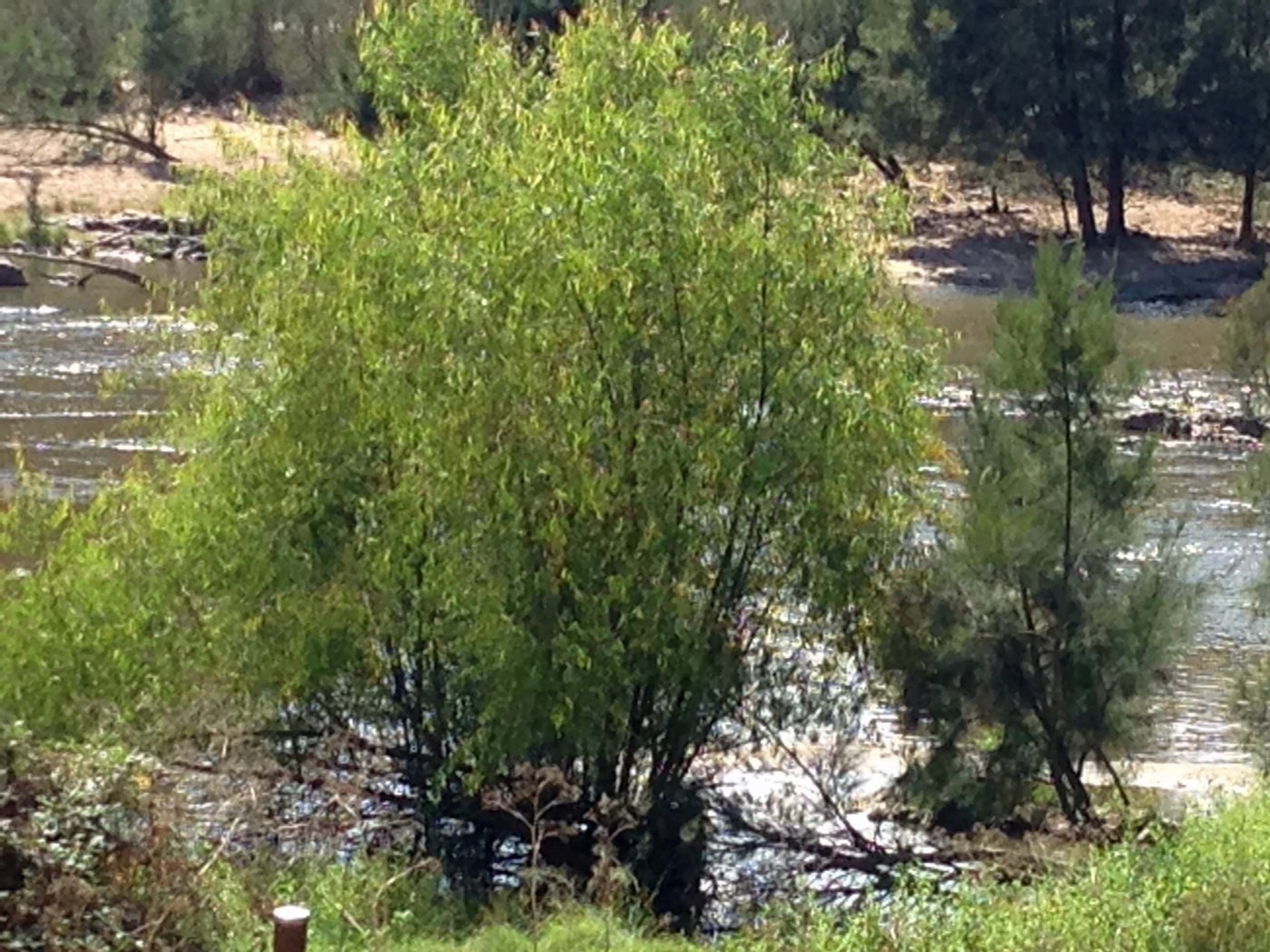When I was a child I loved to play around the “magical” twisted trunk of a huge weeping willow (salix babylonica) in a gully behind the house on Adnamira. It was a little off-putting, however, when I traipsed down the paddock one day with my adventure Barbie dolls, to find a whole nest of baby black snakes all writhing under the roots just where I’d planned to set up camp. Nevertheless, I still have a fondness for weeping willows, from a bit more distance.
Along the Murrumbidgee river we also have black willows (salix nigra), crack willows (salix fragilis) which sound like nasty addicts but merely break easily, basket willows (salix rubens) and possibly white willows (salix alba). Some of them have been growing in huge clumps for at least fifty years. They were always in the same place and I never saw them spread, because they did not seed.
We planted cuttings from some of them along Mullion Creek and around the springs on Adnamira, as a way of stabilizing the banks. It was wonderfully easy to jam them into the soft ground.
The weeping willows I’m not too worried about, but unfortunately, the non-weeping varieties are now able to seed and spread and potentially choke up the river, taking the place of the native casuarinas. That’s a problem, because in the winter when willows drop their leaves, they affect the water quality and temperature, again making the environment more hostile for the native fish and other creatures. I’ve seen areas of the Molonglo river upstream from us that appear to grow nothing but willows. In other places I’ve seen great success with willow control, allowing a refuge for native plants.
It’s only in the last five years that we’ve seen hundreds of new willow seedlings shooting up, meaning the invasion had reached us. So I put “invasive willow eradication” on my list of jobs, waiting for the right moment.
The right moment occurred in the form of Fabian, visiting from Germany in February, who was prepared to tackle a variety of tasks I didn’t want to do alone (or some of them, frankly, at all).
We worked out what tools we would need. I didn’t want to spray the foliage because the spray would go in the water, so we experimented with using a drill to make a hole in the bark and then spray glyphosate directly into it. Unfortunately, we were using the drill on “backwards” so it was surprisingly hard work, and the drill was heavy. It may have felt heavy because I was coming down with flu. Also the first spray bottle I tried simply dripped everywhere. So instead I got a nice sharp handaxe and a cheaper (but more effective) spray bottle and sent Fabian out again while I succumbed to the attack of flu.
The poisoning was a slow process because many of the young trees were growing among the rocks right at the edge, or even in the middle of the river, so Fabian had to wade out around them. Definitely a job for the warmer weather. And the older trees in many cases had been pushed by floods into a tangle of limbs that had to be individually treated.
None of the trees were removed. We’ll just let them rot over time. Any small cut branches were put up high to keep them from taking root.
Things were going well until Fabian came rushing back, covered in European wasp stings. He’d been hanging upside down below a trunk, trying to reach some awkward branches with his axe, so it was hard to get right side up and run away. His face and neck were horribly puffed up, as wasps, unlike bees, can sting over and over.
After he recovered, full of feelings of revenge, we scouted out the tree by night (when European wasps are less active), using red filters on head torches that supposedly meant they could not see us.

Unfortunately, the site was very awkward, slanting sidewards into the trunk. To get really close to it would require balancing across the fallen branches. Also, as we shone our supposedly “invisible” lights into the hole from a distance, I could see insect eyes staring straight back at me. We beat a hasty retreat with our sprays and bottle of diesel fuel. So did Michael Carter a few nights later when he went and checked out the possibility of pouring soap (a contact poison for them) into the hole. We all had to finally admit it was a job for the professionals.
Most recently I went to check on how the willows were going (dying) and found pretty good results. There’ll be more to do next year, but I hope no more wasps.











Hi Barrie, I’d love to do that, but the site is so awkward that (especially in the dark) you’d be very vulnerable to them waking up as you approach. I have someone coming to do termite control anyway.
LikeLike
Yes, they are lovely for playing with boats. It’s part of the British heritage in Australia that they’re so widespread. Even for Australians it’s hard to adjust our eyes and tastes to the beauties of Austalian natives, in comparison to the foreigners. I love that weeping willows were carried along the Silk Road from China, and then many of the Australian ones were twigs picked off by sailing passengers who visited Napoleons tomb in St Helena, and carefully nursed them along by sticking them into raw potatoes. I don’t know if some of them got hungry and just ate the potatoes.
LikeLike
Fascinating, informative. I grew up on the River Thames, pushing my boat under willows, so was particularly interested in this blog entry about willows in Australia.
LikeLiked by 1 person
Thanks Shirley – somehow my reply got separated below…
LikeLike
Hi Fiona – I deal with wasps at night using a can of pressurised mortein.
LikeLiked by 1 person